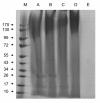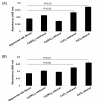Preparation and characterization of silk fibroin as a biomaterial with potential for drug delivery
- PMID: 22676291
- PMCID: PMC3538618
- DOI: 10.1186/1479-5876-10-117
Preparation and characterization of silk fibroin as a biomaterial with potential for drug delivery
Abstract
Background: Degummed silk fibroin from Bombyx mori (silkworm) has potential carrier capabilities for drug delivery in humans; however, the processing methods have yet to be comparatively analyzed to determine the differential effects on the silk protein properties, including crystalline structure and activity.
Methods: In this study, we treated degummed silk with four kinds of calcium-alcohol solutions, and performed secondary structure measurements and enzyme activity test to distinguish the differences between the regenerated fibroins and degummed silk fibroin.
Results: Gel electrophoresis analysis revealed that Ca(NO3)2-methanol, Ca(NO3)2-ethanol, or CaCl2-methanol treatments produced more lower molecular weights of silk fibroin than CaCl2-ethanol. X-ray diffraction and Fourier-transform infrared spectroscopy showed that CaCl2-ethanol produced a crystalline structure with more silk I (α-form, type II β-turn), while the other treatments produced more silk II (β-form, anti-parallel β-pleated sheet). Solid-State 13C cross polarization and magic angle spinning-nuclear magnetic resonance measurements suggested that regenerated fibroins from CaCl2-ethanol were nearly identical to degummed silk fibroin, while the other treatments produced fibroins with significantly different chemical shifts. Finally, enzyme activity test indicated that silk fibroins from CaCl2-ethanol had higher activity when linked to a known chemotherapeutic drug, L-asparaginase, than the fibroins from other treatments.
Conclusions: Collectively, these results suggest that the CaCl2-ethanol processing method produces silk fibroin with biomaterial properties that are appropriate for drug delivery.
Figures






Similar articles
-
Structure and properties of regenerated Antheraea pernyi silk fibroin in aqueous solution.Int J Biol Macromol. 2007 Apr 10;40(5):472-8. doi: 10.1016/j.ijbiomac.2006.11.006. Epub 2006 Nov 24. Int J Biol Macromol. 2007. PMID: 17173967
-
Regenerated silk fibroin films with controllable nanostructure size and secondary structure for drug delivery.ACS Appl Mater Interfaces. 2014 Dec 24;6(24):21813-21. doi: 10.1021/am502278b. Epub 2014 May 29. ACS Appl Mater Interfaces. 2014. PMID: 25536875
-
Silk Fibroin Degradation Related to Rheological and Mechanical Properties.Macromol Biosci. 2016 May;16(5):666-75. doi: 10.1002/mabi.201500370. Epub 2016 Jan 12. Macromol Biosci. 2016. PMID: 26756449
-
Structure of Silk I (Bombyx mori Silk Fibroin before Spinning) -Type II β-Turn, Not α-Helix.Molecules. 2021 Jun 17;26(12):3706. doi: 10.3390/molecules26123706. Molecules. 2021. PMID: 34204550 Free PMC article. Review.
-
Preparation of silk fibroin carriers for controlled release.Microsc Res Tech. 2017 Mar;80(3):312-320. doi: 10.1002/jemt.22606. Epub 2015 Dec 6. Microsc Res Tech. 2017. PMID: 26638113 Review.
Cited by
-
Advances in Preparation and Properties of Regenerated Silk Fibroin.Int J Mol Sci. 2023 Aug 24;24(17):13153. doi: 10.3390/ijms241713153. Int J Mol Sci. 2023. PMID: 37685960 Free PMC article. Review.
-
Utilizing Silk Sericin as a Biomaterial for Drug Encapsulation in a Hydrogel Matrix with Polycaprolactone: Formulation and Evaluation of Antibacterial Activity.ACS Omega. 2024 Jul 16;9(30):32706-32716. doi: 10.1021/acsomega.4c02453. eCollection 2024 Jul 30. ACS Omega. 2024. PMID: 39100358 Free PMC article.
-
Comparative Study of the Preparation of High-Molecular-Weight Fibroin by Degumming Silk with Several Neutral Proteases.Polymers (Basel). 2023 Aug 12;15(16):3383. doi: 10.3390/polym15163383. Polymers (Basel). 2023. PMID: 37631440 Free PMC article.
-
Enhanced transdermal insulin basal release from silk fibroin (SF) hydrogels via iontophoresis.Drug Deliv. 2022 Dec;29(1):2234-2244. doi: 10.1080/10717544.2022.2096717. Drug Deliv. 2022. PMID: 35848994 Free PMC article.
-
Development of ZnO Nanoflake Type Structures Using Silk Fibres as Template for Water Pollutants Remediation.Polymers (Basel). 2020 May 18;12(5):1151. doi: 10.3390/polym12051151. Polymers (Basel). 2020. PMID: 32443444 Free PMC article.
References
MeSH terms
Substances
LinkOut - more resources
Full Text Sources
Other Literature Sources

